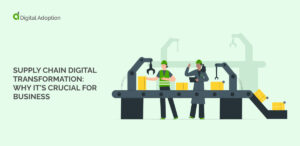The names of frameworks such as TOGAF, ITIL, and COBIT may be familiar to those in the IT profession – but what are they and how are they different from one another?
In this post, we’ll learn the basics of frameworks such as these, how they can be useful, what their pros and cons are, and which ones to apply in which circumstances.
What Are Business Frameworks?
In business, frameworks are everywhere – especially in large enterprises.
Frameworks, regardless of their purpose, tend to serve one common aim: to simplify complex business processes into models that can be easily grasped and applied.
There are frameworks for about every business discipline, department, and function.
For instance:
- There are frameworks that describe the theories of change management and turn them into step-by-step action plans
- Digital maturity models describe the maturity of an organization’s digital capabilities
- Marketing frameworks outline key processes within marketing, such as the customer journey, market sophistication, and more
Each framework has its own use case and its own place in the organization, as we can see from this brief list.
Also, each framework has pros, cons, and considerations that should be taken into account.
For instance:
- Most frameworks have very specific scopes and can only be used to accomplish certain goals
- Some frameworks are incompatible with one another
- Other frameworks haven’t been modernized and are considered out-of-date, if not obsolete
In short, it is important to evaluate one’s own situation and needs before actually applying a framework.
3 Use Cases for IT Frameworks
As hinted at above, IT frameworks can perform several functions – and this makes sense, since IT is so central to the modern organization.
Digital strategies, for example, play a role in nearly every area of the business, from finance to marketing to customer service.
For that reason, IT frameworks cover territory that includes:
- IT governance. IT governance refers to the alignment of IT with business goals. When IT doesn’t sync up with business activities, inefficiencies and problems can quickly crop up. IT governance frameworks, such as those covered later, help to streamline this process and make it easier for IT leaders to do their job.
- IT service management (ITSM). ITSM is a key function within IT departments. It refers to the maintenance and management of IT operations. Since IT service delivery directly impacts key areas, such as the customer experience, it is important to optimize IT operations as much as possible.
- Enterprise architecture. Enterprise architecture overlaps with IT governance. While both tend to focus on IT’s role in the business, enterprise architecture takes a broader perspective. Among other things, it encompasses areas such as people, data, and technology.
These are only three of many examples of how IT frameworks can simplify and improve IT managerial tasks.
Next, let’s look at three key examples of these frameworks.
TOGAF, ITIL, and COBIT, a Quick Rundown
TOGAF, ITIL, and COBIT are, as mentioned, three of the most well-known IT frameworks.
Let’s look at each one in detail to see how they can be applied:
TOGAF
TOGAF is short for The Open Group Architecture Framework.
It is a top-down framework that helps to:
- Align IT goals with business goals
- Help organizations adopt products and software more efficiently
- Simplify development
- Improve collaboration between IT and other departments
As the acronym suggests, “architecture” is a key focus of this framework, and it focuses on several areas, each with architecture at its center:
- Business architecture
- Applications architecture
- Data architecture
- Technical architecture
- Architecture development model
- Enterprise continuum
Each of these components, in turn, has its own subset of processes, practices, and methods.
Since TOGAF is one of the most influential and popular IT frameworks, those interested in learning more about IT tools should investigate this one closely.
Another important one to look at is ITIL, which we’ll cover next.
ITIL
ITIL stands for the IT Infrastructure Library.
This framework focuses on IT service management (ITSM) and provides an in-depth framework that is especially useful for growing or large enterprises.
ITIL’s life cycle has five stages:
- Service Strategy
- Service Design
- Service Transition
- Service Operations
- Continual Service Improvement
Like TOGAF, ITIL’s top-level stages can be further broken down into sub-components, processes, terms, and definitions.
In all likelihood, any IT director is familiar with this framework, if they don’t apply it already.
COBIT
COBIT is short for Control Objectives for Information and Related Technology.
The aim of this framework is to assist with IT governance by managing:
- Business requirements and metrics, such as reliability, effectiveness, and compliance
- IT resources, such as people and infrastucture
- IT processes, which are separated into domain processes
Since COBIT is an IT governance framework, its aim is to, as mentioned above, ensure that IT supports and delivers on the organization’s business needs.
COBIT and the other IT frameworks covered here are three of the most common and most useful ones, both for managing IT and for connecting IT to the rest of the business. There is no such thing as a “best” framework, however – each one should be evaluated according to one’s own needs.













